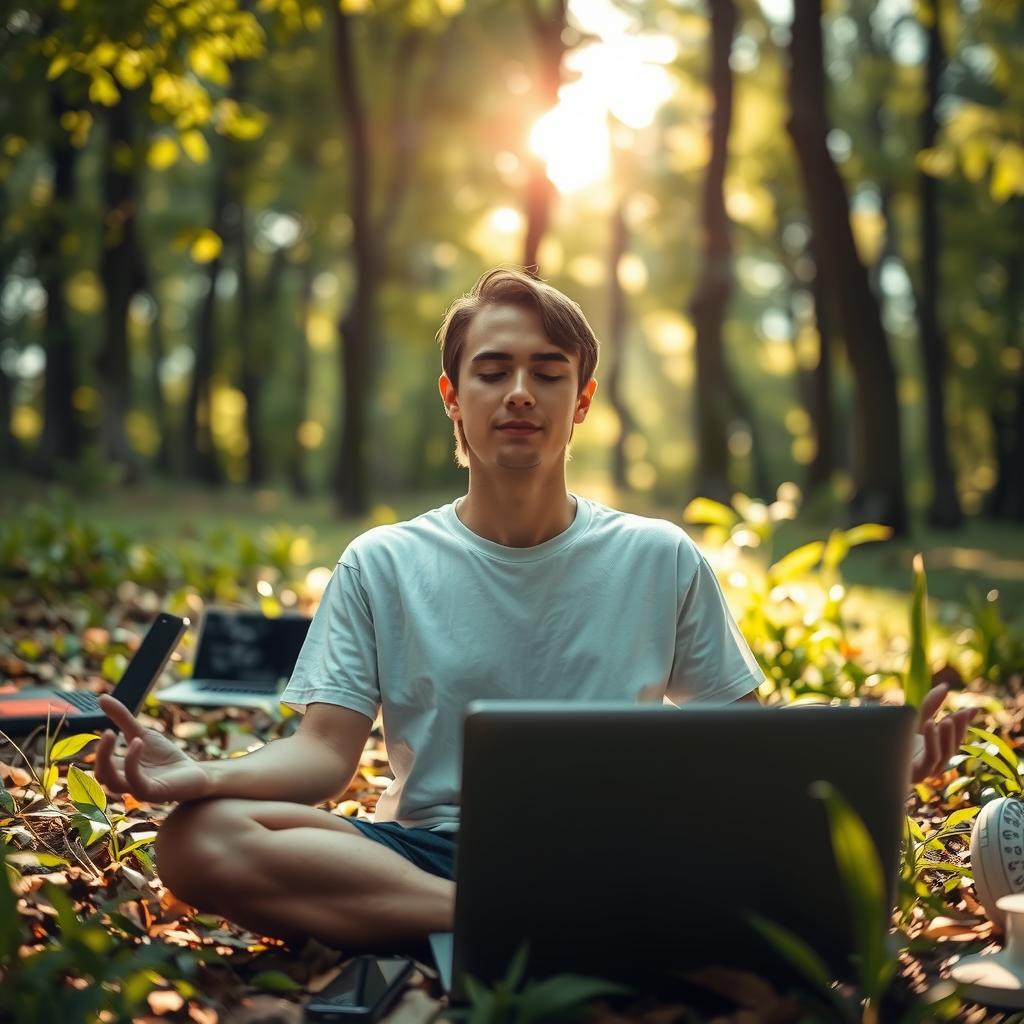In today’s fast-paced digital landscape, the incessant buzz of notifications and the allure of endless scrolling can drown out our ability to think clearly. Many individuals find themselves caught in a cycle where technology, rather than serving as a tool for empowerment, becomes an overwhelming source of stress and distraction. This phenomenon has sparked a growing interest in digital detox strategies that promote mental clarity and enhance overall well-being. As people grapple with heightened anxiety levels and diminished focus due to excessive screen time, recognizing the need for intentional breaks from technology is more crucial than ever.
The core value of this article lies in its exploration of effective methods to reclaim one’s mental space through mindful practices aimed at reducing digital clutter. By implementing targeted screen time management techniques, readers can foster improved emotional health while navigating their daily lives amidst technological distractions. The journey toward achieving balance does not require an all-or-nothing approach; instead, it invites gradual changes that lead to significant improvements in both clarity and focus.
To guide readers on this path to enhanced well-being, this post will delve into various practical strategies designed specifically for those seeking relief from digital fatigue. From integrating mindfulness techniques into daily routines to establishing boundaries around device usage, these actionable insights aim to empower individuals with tools necessary for regaining control over their relationship with technology. Readers will discover how simple adjustments can yield profound effects on their cognitive function and emotional stability.
As we embark on this exploration of digital wellbeing, it becomes evident that small shifts can lead us towards greater awareness and presence in our lives—ultimately paving the way for lasting change. Through understanding the importance of balancing our tech habits with restorative practices, individuals can forge a healthier connection between mind and machine—a connection grounded not only in productivity but also in peace of mind.

Key Highlights:
Essential insights and strategies for achieving mental clarity through effective digital detox practices.
In a world dominated by screens, the overwhelming nature of constant notifications often leads to diminished mental clarity and heightened anxiety. To combat this, individuals are increasingly turning to effective digital detox strategies that prioritize stress relief and promote overall emotional health. One powerful approach involves implementing scheduled breaks from devices throughout the day. By intentionally designating times to disconnect from technology, users can significantly reduce their screen time management, creating opportunities to recharge mentally and emotionally.
Engaging in offline activities is another key strategy that enhances digital wellbeing. Activities such as reading a book, going for a nature walk, or practicing mindfulness techniques not only provide respite from screens but also foster deeper connections with oneself and others. These moments spent away from technology can lead to improved focus improvement and greater mental clarity as they encourage individuals to immerse themselves fully in the present moment rather than being distracted by digital noise.
Furthermore, cultivating a balanced relationship with technology requires awareness of its impact on daily life. Individuals can benefit greatly by incorporating mindful habits into their routines—such as setting specific times for checking emails or social media—to manage their engagement more effectively. This proactive approach allows for better control over screen time, ultimately leading to enhanced emotional health and well-being. As readers explore these actionable tips within the context of their own lives, they may discover valuable pathways toward reclaiming tranquility amid an increasingly connected world while fostering lasting improvements in both focus and mental clarity.

Understanding the Digital Overload
The Weight of Constant Connectivity
In today’s hyper-connected world, screens have become an integral part of daily life, often leading to a state known as digital overload. This phenomenon significantly impacts mental clarity, making it increasingly difficult for individuals to maintain focus and emotional well-being. Research indicates that excessive screen time can lead to cognitive fatigue, diminishing one’s ability to process information effectively. As people grapple with information bombardment from social media, emails, and online news outlets, they may experience heightened stress levels. Consequently, this incessant engagement can hinder clear thinking and memory retention. Digital detox practices are emerging as vital solutions for those seeking a reprieve from this relentless cycle.
The Connection Between Screens and Stress
The relationship between prolonged screen exposure and increased stress is becoming more evident in contemporary studies on digital wellbeing. When individuals find themselves perpetually scrolling through feeds or responding to notifications, their minds remain in a constant state of alertness—an evolutionary response designed for survival but detrimental in modern contexts. This chronic activation of the body’s stress responses can lead not only to anxiety but also impair overall emotional health over time. Mindfulness techniques have been proposed as effective strategies for countering these effects; engaging in regular periods away from screens allows individuals to center themselves mentally while promoting focus improvement.
Strategies for Screen Time Management
Effective screen time management has emerged as essential in combating the adverse consequences associated with excessive digital engagement. Setting specific boundaries around device usage is crucial; implementing structured breaks throughout the day helps mitigate feelings of overwhelm caused by endless notifications or content consumption patterns that distract rather than enrich one’s life experience. Many experts recommend establishing technology-free zones within homes or workplaces where mindfulness practices can flourish without digital interruptions—creating spaces dedicated solely to relaxation or creativity fosters an environment conducive to improved mental clarity.
Embracing Technology Balance
Finding harmony between technological benefits and personal well-being entails embracing a balanced approach toward device usage—a concept referred to as technology balance. It necessitates recognizing when devices add value versus when they detract from quality moments spent offline with loved ones or indulging in hobbies that promote joy outside the realm of screens. By implementing intentional habits like prioritizing face-to-face interactions over virtual ones during downtime hours contributes positively towards individual emotional health while reinforcing relationships built on genuine connections rather than mere pixels on display.
Cultivating Mindfulness Amidst Chaos
Even amidst chaotic schedules filled with responsibilities demanding attention at every turn—from work obligations spilling into personal lives—to demands placed upon one’s dwindling free time due largely influenced by omnipresent tech culture—the cultivation of mindfulness remains paramount if clarity is sought after amid noise cluttering thought processes originating primarily via electronic devices’ persistent allurements invading everyday existence disrupting natural rhythms experienced previously before such advances became commonplace fixtures shaping routine lifestyles today regardless whether one acknowledges impact felt internally externally alike both realms interconnected undeniably tethered intricately woven together fostering profound shifts occurring gradually unnoticed until awareness awakened triggered acknowledging pressing need address imbalances created inadvertently through habitual tendencies formed unconsciously neglecting self-care principles foundational underpinning meaningful living ultimately guiding towards healthier outcomes desired enhancing overall satisfaction derived holistic approaches utilized integrating easier paths navigating complexities inherent managing various aspects life harmoniously while nurturing deeper understanding appreciation surroundings enriching experiences shared collectively transcending limitations imposed solely attributable shifting paradigms evolving continually adapting needs arising dynamically challenging status quo entrenched firmly faced forward direction intent reaching beyond confines established norms striving elevate consciousness elevating both quality quantity interactions sustained pivotal aspects ensuring positive transformations unfold organically flourishing vibrantly nourished care compassion infused into every interaction pursued proactively grounded solidly present moment unraveling possibilities awaiting discovery illuminating pathways leading brighter futures envisioned hopeful aspirations cherished engendered intentionally foster growth evolve naturally alongside journey traversed individually collectively embraced wholeheartedly reflective intentions guiding choices made consciously mindfully nurtured attentively mindful engagement facilitates thriving environments wherein all flourish abundantly thriving richness found simplicity residing within grasp effortlessly attained realizing true potential waiting patiently reveal itself once freed barriers holding back progress stifled long enough finally liberated unleashed truth longing expressed unfiltered authentic raw purity emerges illuminating beauty resides everywhere encompassing entire existence enlivened vibrant energy flowing freely radiating outward touching lives countless souls embarked similar journeys seeking answers fulfillment happiness peace tranquility resonating deeply profoundly transforming essence surrounding realms infusing light love unity harmony wherever ventured forth blossoming beautifully weaving intricate tapestries connecting realities bridging divides creating symbiotic relationships rooted trust respect authenticity empowering collective evolution catalyzing profound change ushered realization interdependence thrives reminding interconnectedness celebrated cherished uplift humanity uplifting spirits soaring heights unimaginable embarking transformative quests unlocking limitless potentials housed within each individual bravely stepping forth claiming rightful place universe belonging fully alive engaged purpose fulfilled intimately aligned heart soul intertwined magnificently orchestrated cosmic dance celebrating uniqueness diversity harmonized serenading symphony emanates divine resonance echoing eternity inviting everyone join harmonious chorus lifting vibrations higher spreading love kindness grace envelops world wrapping gently warm embrace inviting exploration adventure unfolding endless possibilities lying dormant yearning awake reclaim rightful heritage bestowed birthright infinite treasures await discovery beckoning seekers tread path illuminated brightly shining stars above tw

Mindfulness Techniques for Digital Detox
Rediscovering Life Beyond Screens
In today’s hyper-connected world, the constant presence of digital devices can lead to overwhelming stress and emotional fatigue. To help individuals reclaim their peace, practical digital detox strategies are essential. By employing effective mindfulness techniques, one can significantly reduce screen time while enhancing emotional health and achieving a better balance with technology. One approach is to establish specific “no screen” zones in daily life—places where technology is kept at bay, encouraging an environment conducive to relaxation and introspection. For instance, designating mealtimes as tech-free moments allows for deeper connections with loved ones and fosters gratitude for the food consumed. Engaging fully in these experiences can lead to improved mental clarity and create lasting memories that easily overshadow any fleeting satisfaction gained from scrolling through social media feeds.
Another impactful strategy involves incorporating regular breaks during the day dedicated solely to mindfulness practices such as meditation or deep breathing exercises. These simple yet powerful activities not only serve as a respite from screens but also promote significant stress relief by grounding individuals in the present moment. Research has shown that even short sessions of mindful breathing can enhance focus improvement, leading to increased productivity once screen time resumes. Furthermore, keeping a journal or practicing gratitude during these breaks fosters self-awareness about one’s use of technology; it encourages reflection on how often screens are used out of habit rather than necessity.
Screen Time Management Strategies
Creating Boundaries for Better Emotional Wellbeing
Effective management of screen time is vital for enhancing overall digital wellbeing—a concept gaining traction among those seeking harmony between their online activities and emotional wellness. A crucial aspect lies in setting clear boundaries around device usage throughout the day; this includes defining specific hours when notifications will be silenced or turning off devices altogether before bedtime to ensure restorative sleep cycles aren’t disrupted by late-night browsing habits. Studies have indicated that reducing evening exposure helps improve sleep quality while simultaneously promoting healthier daytime routines focused on face-to-face interactions rather than virtual ones.
Moreover, cultivating hobbies unrelated to screens serves as an excellent way to engage both body and mind effectively without succumbing entirely into digital distractions. Activities like painting, gardening, or reading physical books enable individuals not only to explore new interests but also offer opportunities for genuine relaxation—a stark contrast against incessant notifications vying attention every few seconds across various platforms. This shift towards more tangible pursuits ultimately supports emotional health by providing fulfilling alternatives that prioritize personal growth over passive consumption prevalent through many online channels.
By intertwining these practical strategies within daily routines alongside consistent mindfulness efforts aimed at reducing screen dependency levels steadily progresses toward greater well-being overall—an achievable goal everyone should aspire toward amidst our tech-saturated culture today!
Cultivating Balance: Achieving Harmony Between Digital Life and Real-World Interactions
Integrating Offline Activities for Enhanced Wellbeing
In today’s hyper-connected world, the need for a harmonious balance between digital engagements and real-world interactions has never been more crucial. The overwhelming presence of screens in daily life often leads to increased stress levels, reduced mental clarity, and compromised emotional health. To combat these issues effectively, individuals are encouraged to embrace mindfulness techniques that promote digital detox while integrating offline activities into their routines. By prioritizing activities such as reading a physical book or enjoying nature walks, people can experience significant improvements in their focus and overall happiness. Engaging in these offline experiences not only fosters deeper connections with others but also enhances one’s ability to manage screen time effectively.
Incorporating simple yet impactful practices into daily life can yield substantial benefits. For instance, setting aside specific times for technology-free meals encourages meaningful conversations among family members or friends. This practice not only strengthens relationships but also provides an opportunity for mindful eating—a vital aspect of maintaining both physical well-being and emotional health. Furthermore, dedicating moments throughout the day for short breaks from screens allows individuals to recharge mentally; thus promoting stress relief and improving focus when they return to their tasks.
Beyond personal relationships, fostering a balanced approach towards technology usage contributes positively to overall digital wellbeing. As one becomes more aware of how much time is spent on devices versus engaging in fulfilling offline pursuits like hobbies or sports, it becomes easier to establish boundaries around screen time management. These boundaries serve as protective measures against the distractions that pervasive technology often brings into everyday life.
Moreover, participating in group activities such as team sports or community events serves as an excellent avenue for cultivating social interactions outside digital platforms—reinforcing feelings of belongingness while simultaneously alleviating feelings of isolation that can arise from excessive online engagement. Such collective experiences are essential components of nurturing emotional health within communities.
Ultimately, by consciously making room for offline engagements amidst our tech-driven lives—whether through art classes or outdoor adventures—individuals can achieve greater inner peace and balance between their virtual existence and tangible reality. This careful integration facilitates improved focus improvement during work hours while empowering minds with restored clarity necessary for navigating life’s challenges gracefully—all rooted deeply within the framework provided by intentional living choices made each day.
FAQs:
Q: What are some effective digital detox strategies for improving mental clarity?
A: Implementing scheduled breaks from screens can significantly enhance mental clarity. For instance, individuals can set specific times during the day to disconnect from devices, allowing their minds to refresh and refocus. Additionally, engaging in offline activities such as reading a book or taking a walk in nature not only promotes stress relief but also fosters a healthier relationship with technology.
Q: How does reducing screen time contribute to better emotional health?
A: Reducing screen time is directly linked to improved emotional health. When individuals minimize their exposure to constant notifications and digital distractions, they often experience lower levels of anxiety and increased focus. By practicing mindfulness techniques like meditation or deep breathing exercises during these breaks, one can cultivate a sense of calm that enhances overall well-being.
Q: What role do mindfulness techniques play in achieving technology balance?
A: Mindfulness techniques are essential for achieving balance amidst the chaos of modern living dominated by technology. By incorporating practices such as mindful observation or gratitude journaling into daily routines, individuals can develop greater awareness of their emotions and reactions related to screens. This heightened awareness allows for better screen time management and ultimately leads to enhanced productivity and happiness in both personal and professional spheres.

Add a Comment